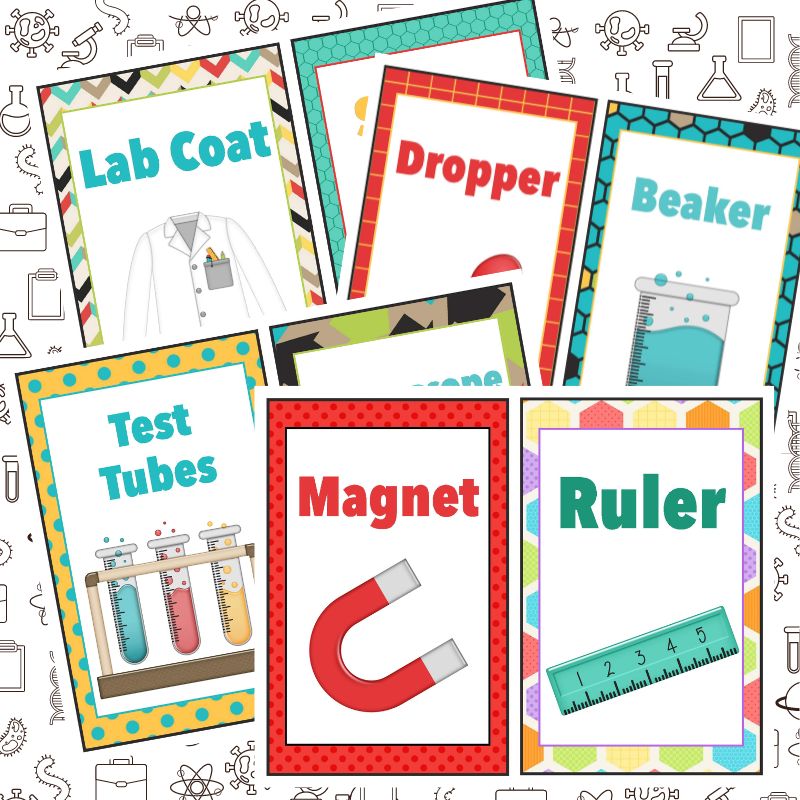Does a scientist use tools? Yes! Scientists use tools to explore the world around them. Whether observing the stars with binoculars, measuring the weather, or studying life in a drop of water, science tools are essential for making discoveries and setting up simple science experiments!
Using Scientific Tools
Science is all about asking questions and exploring the world! Different types of scientists use various tools in their labs to measure, observe, and experiment to find answers to their questions.
💡 With these tools, young scientists can explore everything from biology and chemistry to physics and earth science. Through hands-on experiments and lessons, kids can dive into exciting exploration while learning about the world around them.
Recommended Grade Levels: This list of favorite science tools is perfect for elementary school students from kindergarten to 5th grade (even middle school). It’s a great introduction to simple, more advanced science equipment that kids can use safely. See Pre-K recommendations below.
Favorite Science Tools
Go ahead and assemble a science kit with some of these tools! Add them to a science center with a specific theme or leave a few loose, such as a magnifying glass, for any observation time.
💡 Make sure to learn about the scientific method and variables to expand on your activities.
- Test Tubes: Small glass containers used to hold liquids during experiments, especially in chemistry.
- Microscope: A tool that helps you see things too tiny for the naked eye, like plant cells or water droplets—perfect for biology!
- Beaker: A container used to mix or heat liquids during science activities.
- Dropper: A tool for transferring small amounts of liquid, great for careful measurements.
- Thermometer: Measures temperature, whether it is how hot the sun is or how cold ice is.
- Magnet: Used to explore magnetism and how it interacts with different materials.
- Scale: Helps weigh objects or measure how heavy things are, like rocks or fruits.
- Petri Dish: A small dish that grows tiny organisms like mold or bacteria.
- Goggles: Protects your eyes during experiments—safety first!
- Ruler: Measures lengths and distances, perfect for comparing plant growth or measuring objects.
- Magnifying Glass: A classic tool for scientists to observe small details up close, like the veins on a leaf or the texture of a rock.
- Stopwatch: Times your experiments, great for activities that involve observing changes over time.
- Molecule Model: Helps students understand what molecules look like and how different atoms connect to form compounds.
- Binoculars: A tool that helps you see things far away, great for outdoor exploration of animals or nature.
Hands-On Science Experiment Suggestions for Older Kids
Now that you know some essential science tools, let’s experiment! Here are some fun and simple science experiments you can do with these tools in a science lab.Water Drop Microscope (Grades 2-5) Use a microscope to examine drops of pond water. What tiny organisms can you spot?
Special Tools for Preschool Science
Preschoolers love hands-on exploration, and while they may not need advanced tools, there are special science tools designed just for little hands to spark their curiosity.
- Plastic Magnifying Glass: A simple, child-safe tool that lets young scientists get an up-close look at bugs, leaves, and rocks.
- Kid-Sized Tweezers: These are perfect for small hands to pick up objects like seeds, pebbles, or tiny insects for observation.
- Sensory Bottles: Sealed plastic bottles filled with water, glitter, beads, and other objects, allowing preschoolers to observe movement, color, and floatation mess-free.
- Measuring Cups and Spoons: Great for water play, sand exploration, or simple science experiments where preschoolers can measure, pour, and compare quantities.
- Color-mixing droppers: These droppers, filled with safe, colored water, help kids explore the concepts of color mixing and observation.
- Binoculars: Lightweight and easy-to-use preschool binoculars allow kids to explore the outdoors and observe birds or clouds at a distance.
- Simple Thermometer: A color-changing or easy-to-read thermometer can help preschoolers understand hot and cold concepts in weather or water play.
- Observation Jars: Clear plastic jars with magnifying lids allow young kids to observe small objects they collect during outdoor exploration safely.
Hands-On Experiment Ideas for Preschoolers:
Color Mixing: (Ages 3-5) Use color-mixing droppers with water to blend primary colors and see what new colors appear! Science Tools: Color Mixing Droppers, Measuring Cups
Nature Observation: (Ages 4-5) Collect small nature items in observation jars or use a plastic magnifying glass to observe them up close. Kids can describe what they see.
Science Tools: Plastic Magnifying Glass, Observation Jar
Sink or Float: (Ages 3-5) Use measuring cups and different objects (like stones, leaves, or plastic toys) to explore what sinks and what floats in water.
Science Tools: Measuring Cups, Sensory Bottle
Outdoor Bird Watching: (Ages 3-5) Head outdoors with binoculars and observe birds or clouds. Kids can point out shapes, colors, and movements. Make a bird feeder and print our mini bird pack to get started.
Science Tools: Binoculars, Kid-Sized Tweezers (for collecting leaves or other small objects)
Magnetic Treasure Hunt: (Ages 3-5) Hide small magnetic objects (like paperclips or coins) in a sandbox or sensory bin. Let the children use magnets to “hunt” and pull the treasures out of the sand! Science Tools: Magnet, Kid-Sized Tweezers

